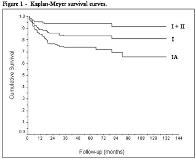SURGICAL OUTCOME OF TEMPORAL LOBE EPILEPSY DUE TO HIPPOCAMPAL SCLEROSIS - A SINGLE ETIOLOGY GROUP SURVIVAL ANALYSIS
Abstract number :
2.440
Submission category :
Year :
2004
Submission ID :
4889
Source :
www.aesnet.org
Presentation date :
12/2/2004 12:00:00 AM
Published date :
Dec 1, 2004, 06:00 AM
Authors :
1,2Eliseu Paglioli, 1Andre Palmini, 1Jaderson Costa, 1Mirna Portuguez, 1Ney Azambuja, and 1Eduardo Paglioli
Surgical treatment is usually indicated for patients with medically refractory mesial temporal lobe epilepsy due to unilateral hippocampal sclerosis (MTLE/HS). Nonetheless, there is still debate on the actual rates of postoperative seizure control and the stability of surgical results over time. Most outcome studies of temporal resections include patients with different etiologies, and this may preclude preoperative prognostication based on specific etiological substrates. Surgical outcome in relation to seizure control and post-operative motor and language complications were analyzed yearly for all 135 consecutive patients operated for MTLE/HS, from January 1992 to December 2000. These were drawn from a total of 437 patients operated for intractable epilepsy in the same period, 226 of which had surgery for TLE. In addition to the 135 with HS (60%), 49 patients with TLE had low-grade gliomas, nine had nonspecific gliosis, seven had cavernomas, and five had dysgenetic lesions, and in the remaining 21 MRI and pathology were normal. Patients were followed for a minimum of two up to 11 years, with a mean of 5.47. One (0.7 %) was lost to follow up. Outcome was analyzed using Engel s classification through Kaplan-Meier estimated survival curves (as a function of the time to seizure recurrence) and at the last updated follow up. The probability of a given patient to remain in outcome class IA after one, two, five, and 10 years post-surgery was 85%, 77%, 74%, and 66% (see figure 1). Mean survival time in this outcome class was 8.03 years (95% CI: 7.22 - 8.84). Furthermore, the probability of survival in outcome class I (A, B or D) at the same post-operative points in time was 89%, 86%, 83%, and 81%. With a mean survival time of 9.23 years (95% CI: 8.57 - 9.89). Finally, probability of survival in either outcome class I or II at years one, two, five, and 10 after operation was 96%, 94%, 94%, and 91% (mean survival time, 10.26 years; 95% CI: 9.80 - 10.73).Only nine patients (6.7%) had outcome classes III or IV at any point during follow up.[figure1] Seizure free rates in patients with MTLE/HS are considerably higher than those reported when patients with different etiologies of TLE are pooled as a group. High rates of seizure freedom can be obtained and remain stable over the years in patients operated for unilateral MTLE/HS, even in countries with limited resources.
